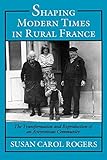Shaping Modern Times in Rural France : The Transformation and Reproduction of an Aveyronnais Community / Susan Carol Rogers.
Material type: TextPublisher: Princeton, NJ : Princeton University Press, [2021]Copyright date: ©1991Description: 1 online resource (248 p.)Content type:
TextPublisher: Princeton, NJ : Princeton University Press, [2021]Copyright date: ©1991Description: 1 online resource (248 p.)Content type: - 9780691226842
- Ethnology -- France -- Sainte Foy (Aveyron)
- Ethnology -- France -- Sainte Foy (Aveyron)
- Families -- France -- Sainte Foy (Aveyron)
- Families -- France -- Sainte Foy (Aveyron)
- Social change
- HISTORY / Europe / France
- Amicale movement
- Catholic church
- Decazeville
- European Economic Community
- French institutions
- Lorraine
- Occitane
- Rodez
- Rouergue
- Ségala
- agricultural markets
- anthropology
- archival sources
- behavior, aberrant
- bourg: appearance of
- census
- cohabitation
- community relations
- conflict
- education
- fair (monthly)
- family history
- family relations
- gros ostals
- household composition
- human agency
- identity: individual
- inheritance
- leisure activities
- migration
- modernization
- municipal crisis
- ostal system
- ostals
- patois
- patron-client ties
- pistonnage
- politics, local
- regionalist movements
- sociability
- social stratification
- sociocultural reproduction
- standards of living
- stem family
- technological innovation
- tourism
- urbanization: of Aveyron
- voluntary associations
- 306/.0944/74 20
- GN585.F8
- GN585.F8 R64 1991
- online - DeGruyter
| Item type | Current library | Call number | URL | Status | Notes | Barcode | |
|---|---|---|---|---|---|---|---|
 eBook
eBook
|
Biblioteca "Angelicum" Pont. Univ. S.Tommaso d'Aquino Nuvola online | online - DeGruyter (Browse shelf(Opens below)) | Online access | Not for loan (Accesso limitato) | Accesso per gli utenti autorizzati / Access for authorized users | (dgr)9780691226842 |
Frontmatter -- Contents -- Illustrations -- Tables -- Acknowledgments -- Prologue. Snapshots from a Moving Picture -- 1. Introduction -- 2. Variations on a Theme: Cultural Specificities and Economic Change in Ste Foy, Aveyron -- 3. Ste Foy's Soul: The Principles of the Ostal System -- 4. Ties That Cut and Bind: Ostals in the Community -- 5. Real Ostals in a Changing World -- 6. New Crises: Structures and Change in Ste Foy -- 7. Conclusions -- Appendix I. Estimations of Ostal Domestic Life Cycles -- Appendix 2. Succession of Households on a Ste Foyan Hamlet -- Bibliography -- Index
restricted access online access with authorization star
http://purl.org/coar/access_right/c_16ec
Challenging the notion that modernization is a homogenizing process, Susan Rogers contends that in the course of large-scale transformations communities often reproduce and strengthen distinctive cultural and social features. To make this argument, she focuses on the French farming community of "Ste Foy" during a period of rapid change (1945-75). Using ethnographic field data and archival material that she collected as a "participant-observer," she finds an intriguing puzzle: an allegedly archaic social form, the ostal, has become increasingly common in the community. The ostal, a type of family farm organized around an extended "stem family" household, is a variant of the stem family systems associated with preindustrial southern Europe. How have Ste Foyans continued to remake this "archaic" mode as their community grew more prosperous and more involved in national and international markets? In showing how the specific identity of a community is reproduced rather than obliterated by modernization, the author reveals dialectical relationships between structure and change, history and culture, and the centralized nation-state and regional diversity. This analysis addresses anthropologists, historians, and scholars interested in local politics and economic development.
Mode of access: Internet via World Wide Web.
In English.
Description based on online resource; title from PDF title page (publisher's Web site, viewed 01. Dez 2022)


